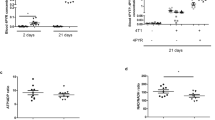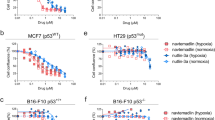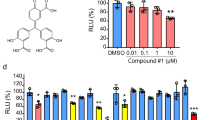Abstract
Nitro-L-arginine inhibits the production of nitric oxide and can thereby cause vasoconstriction in vivo. One consequence of this is that nitro-L-arginine can increase hypoxia in a range of transplantable and spontaneous murine solid tumours. Bioreductive drugs such as RB6145 are more active under hypoxic conditions, and the combination of RB6145 with nitro-L-arginine in vivo shows greater anti-tumour activity than either agent individually. In mice given nitro-L-arginine at 10 mg kg(-1) i.p. up to 1 h before or after 300 mg kg(-1) i.p. RB6145, survival of KHT tumour cells was reduced by 3-4 logs when assessed by clonogenic assay 24 h after treatment. RB6145 or nitro-L-arginine alone caused no more than 20% cell kill. Similar effects were found in SCCVII tumours. The tumour response to the drug combination was tumour size dependent, with increased tumour cell sensitivity occurring when the tumour volume at the time of treatment was increased. Further, the response of KHT tumours to the combination of RB6145 and nitro-L-arginine was also dependent on the time interval between treatment and on when tumours were excised for determination of survival in vitro. The relative surviving fraction was about 0.3 for intervals less than 4 h but was reduced to 0.01 at 12 h and 0.001 at 24 h. These results were supported by histological examination of tumours, when necrosis at 2 h after treatment was less than 5% but increased to greater than 90% at 24 h. RB6145-induced normal tissue damage, as measured by CFU-A survival, was not altered by combining with nitro-L-arginine. Hence, this drug combination may provide therapeutic benefit. It is likely that the substantial anti-tumour effects are due to enhancement of bioreductive toxicity through increased tumour hypoxia, although additional mechanism(s) may also contribute to the overall response.
This is a preview of subscription content, access via your institution
Access options
Subscribe to this journal
Receive 24 print issues and online access
$259.00 per year
only $10.79 per issue
Buy this article
- Purchase on Springer Link
- Instant access to full article PDF
Prices may be subject to local taxes which are calculated during checkout
Similar content being viewed by others
Author information
Authors and Affiliations
Rights and permissions
About this article
Cite this article
Butler, S., Wood, P., Cole, S. et al. Enhancement of bioreductive drug toxicity in murine tumours by inhibition of the activity of nitric oxide synthase. Br J Cancer 76, 438–444 (1997). https://doi.org/10.1038/bjc.1997.407
Issue Date:
DOI: https://doi.org/10.1038/bjc.1997.407



